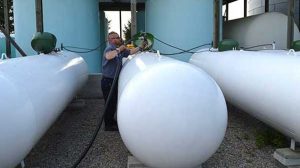Why bring renewable propane to the market?
The article was dated Oct. 7, 2017. The headline read, “California Air Resources Board Issues Lowest Ever Carbon Intensity Score.”
The score was issued for a renewable transportation fuel that can be blended with an existing fossil fuel without any changes to the distribution system or modification of the technology of the vehicle. Unfortunately, the fuel was not propane but renewable natural gas.
In addition, the carbon intensity score, a measure of the carbon impact of a transportation fuel, was lower than electricity by a factor of eight, when used in a vehicle. This is encouraging because it proves that traditional fuels such as natural gas and propane provide a better alternative than electric vehicles.
It is easy to say, “That is a California problem and not an issue that will affect the rest of the United States” or that this only applies to the transportation sector, which is “not part of my business anyway.” However, I respectfully submit that in the future, renewable energy will affect all energy sources and all sectors – agricultural, residential, commercial and transportation – whether we like it or not.
If liquefied petroleum gas, known as propane in the United States, expects to brand itself as a modern “fuel of the future” energy source, it must continually strive to improve its environmental performance and deliver a cost-competitive product to customers. Other energy sources – including electricity, diesel and gasoline – are busily working to add a renewable component to their offerings.
Why not propane?
The most common argument against expending any effort to bring renewable propane to the market is that American production far exceeds demand. The United States exports more than 1.2 billion gallons of propane in any given month. Initially, this argument seems valid and logical. However, the flaw in this logic is that it ignores the opportunity cost of not having renewable propane.
The natural gas industry is vigorously pursuing renewable natural gas despite the newfound abundance of traditional fossil-based natural gas. Nearly all competing energy sources possess a renewable component, and we’re in a race to meet growing environmental demands from policymakers and the public.
In early November, the California Senate passed legislation that would require all power to be generated by renewable energy sources by 2045. Numerous European nations and cities are passing similar laws. If the propane industry had an offering of 20 percent renewable propane and 80 percent fossil propane (R20), we would become a solution for numerous public policy objectives versus a complacent bystander watching other industries surpass us.
Perhaps the greater opportunity cost is gallon growth. Consider the following example. A small group of propane industry marketers has identified five existing facilities that, combined, could produce about 34 million gallons of renewable propane from production that today is unused waste.
These facilities are producing renewable diesel and jet fuel from dairy and beef tallow feedstocks. Thirty-four million gallons may not seem like much, but when you consider the ratio of R20 propane, 304 million gallons of total propane demand is created – 270 million gallons of fossil propane and 34 million gallons of renewable propane.
In this example, I would offer that 270 million gallons more fossil propane demand growth was created that otherwise would not have been. And there are numerous other opportunities to increase renewable propane production levels.
On the farm, in a zero net energy home, in lawnmowers and vehicles, R20 will enhance sales opportunities for our industry. The perception of our energy source – both from a policy and a consumer standpoint – will be enhanced by having a renewable option. This is not a science project. Propane is an important energy source and we must position ourselves to be on equal footing with competing sources that have renewable solutions.
The U.S. propane industry ignores this opportunity at its own peril. If we expect to grow gallons while ignoring public perception and policymakers’ goals, we risk losing the status as a viable energy source in the future. It is past time that we initiate a serious discussion on renewable propane if we intend to position our energy source as a modern fuel.
Stuart Weidie is the president and CEO of Blossman Gas and the immediate past chairman of the National Propane Gas Association.

















